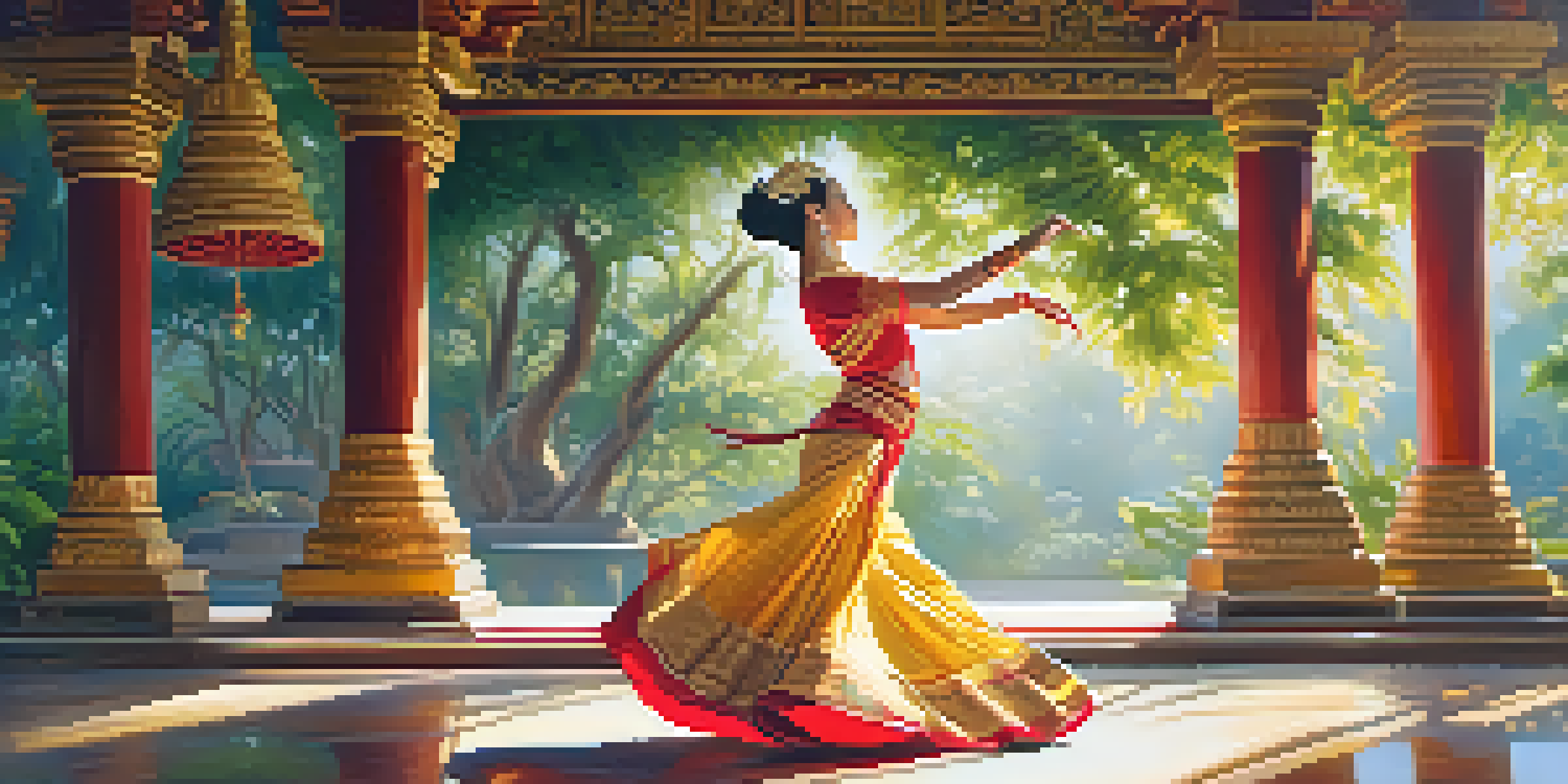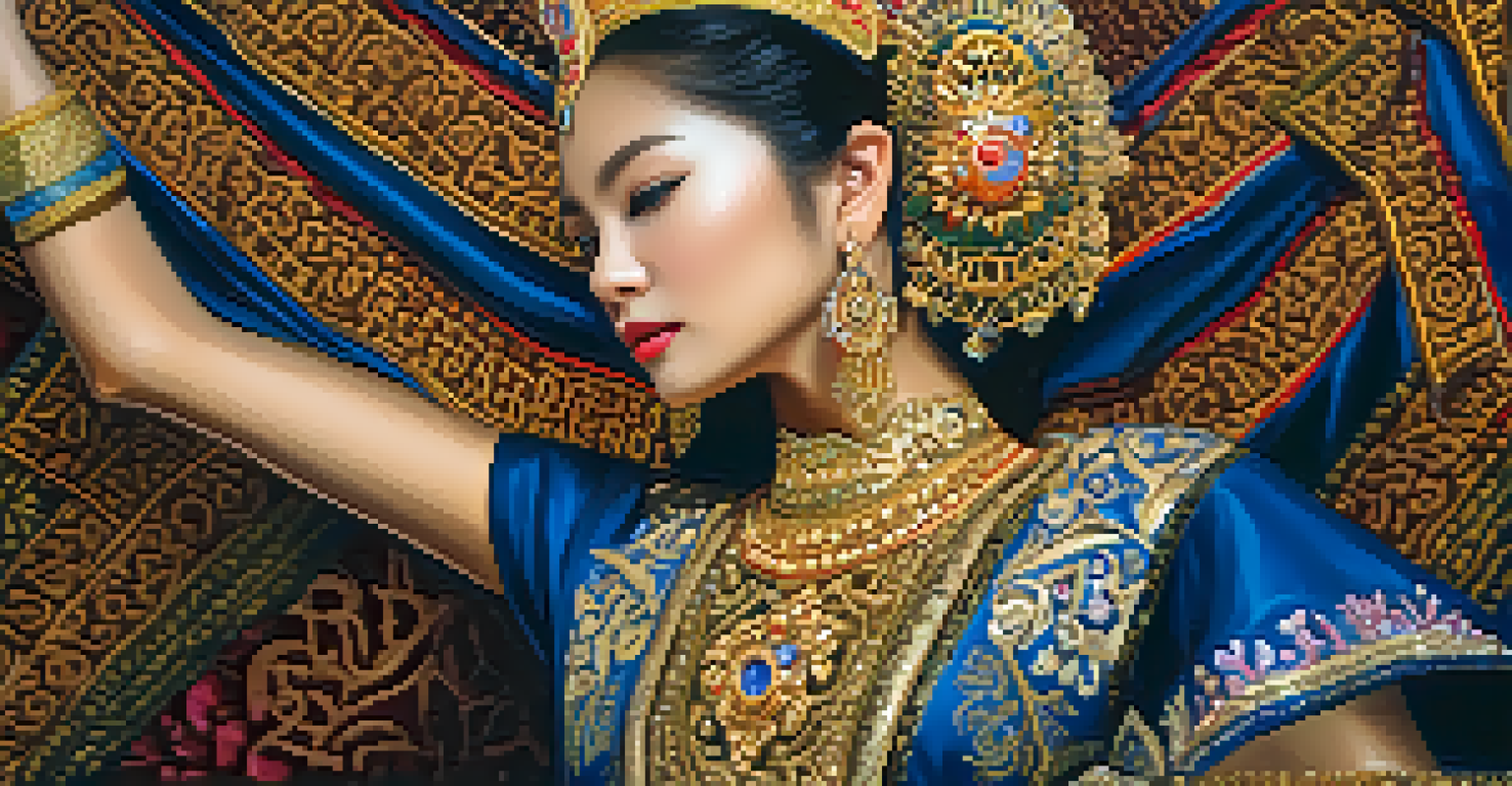Traditional Thai Dance: A Graceful Expression of Culture

The Rich History of Traditional Thai Dance
Traditional Thai dance has a history that stretches back centuries, deeply rooted in the country's rich cultural heritage. Originating from royal courts and temples, these dances were initially performed to honor the gods and entertain royalty. Over time, they have evolved, incorporating various regional styles and influences that reflect the diverse cultural tapestry of Thailand.
Dance is the hidden language of the soul.
Each dance tells a story, often drawn from Thai mythology and historical events, showcasing the country's values, beliefs, and traditions. This storytelling aspect makes traditional Thai dance not just an art form but a medium for cultural expression. For instance, the Ramayana, a famous epic, has inspired numerous dance performances, captivating audiences with its dramatic tales.
Today, these dances continue to play a vital role in Thai society, especially during festivals, religious ceremonies, and cultural celebrations. They serve as a reminder of the past while engaging new generations in the appreciation of their heritage.
Key Elements of Traditional Thai Dance
Traditional Thai dance is characterized by its graceful movements and intricate gestures, often referred to as 'ram' and 'khon.' Dancers use their entire body to express emotions, with hand movements and facial expressions playing a crucial role in storytelling. For example, a slight tilt of the head or a delicate turn of the wrist can convey a wealth of meaning.

Costumes also play an essential part in these performances, often adorned with gold and intricate designs that reflect the dancer's character and the story being told. The vibrant colors and elaborate accessories enhance the visual appeal, drawing the audience into the performance. Each costume is carefully crafted to reflect the cultural significance of the dance, making it a visual feast.
Cultural Heritage in Dance
Traditional Thai dance serves as a vital medium for storytelling and cultural expression, reflecting the rich heritage of Thailand.
Music accompanies these dances, typically featuring traditional instruments like the ranat (xylophone) and the pi (flute). The rhythm and melody guide the movements, creating a harmonious blend of sound and motion. This synergy between music, dance, and costume creates an immersive experience that captivates audiences.
Different Styles of Thai Dance
There are several distinct styles of traditional Thai dance, each with its unique characteristics and themes. For instance, the Khon dance is a classical form that often portrays the epic tales of the Ramayana, featuring elaborate masks and costumes. This style is known for its highly stylized movements and dramatic storytelling, making it a favorite among audiences.
The dance is a poem of which each movement is a word.
Another popular style is the Fawn Thai, which includes both solo and group performances, often showcasing the beauty of Thai culture through graceful movements. This dance is more fluid and less formal than Khon, allowing for greater expression and variation. Performers often portray themes of nature, love, and daily life, making it relatable to the audience.
Moreover, regional styles like the Isaan and Lanna dances highlight the diversity of Thai culture. Each region has its own traditional costumes, music, and dance movements, reflecting local customs and traditions. This variety enriches the overall landscape of Thai dance, offering something for everyone to enjoy.
Cultural Significance of Thai Dance
Thai dance is more than mere entertainment; it holds immense cultural significance within the Thai community. It serves as a medium for passing down stories, morals, and traditions from one generation to the next. Through dance, cultural values such as respect, harmony, and beauty are conveyed, reinforcing a sense of identity among the Thai people.
Moreover, these dances are often performed during important cultural events and religious ceremonies, such as weddings and festivals. They play a crucial role in celebrating national pride and unity, bringing communities together in shared experiences. For instance, the Songkran festival features lively dance performances that reflect the joyous spirit of the occasion.
Diverse Dance Styles
Various styles of Thai dance, such as Khon and Fawn Thai, showcase unique themes and movements, highlighting the country's regional diversity.
In recent years, traditional Thai dance has gained international recognition, allowing it to become a bridge between cultures. Performances in various countries showcase the beauty of Thai heritage, fostering appreciation and understanding of Thai culture on a global scale.
Learning Traditional Thai Dance
For those interested in experiencing the beauty of Thai dance firsthand, many schools and institutions offer classes for beginners. These classes often cover the basics of posture, movements, and expressions, enabling students to grasp the fundamentals of this art form. Learning to dance is not just about mastering the steps; it's also about understanding the cultural context behind each movement.
Participating in a traditional dance class can be an enriching experience, providing insights into Thai culture and history. Students often find themselves immersed in the rhythm and grace of the dance, forging a deeper connection with the art form. Additionally, many dance schools encourage students to participate in cultural performances, allowing them to showcase their skills and share their newfound passion.
Moreover, workshops and cultural exchanges often include dance as a key component, helping to promote cross-cultural understanding. These opportunities allow people from different backgrounds to come together, learn, and appreciate the richness of Thai traditions.
Modern Influences on Thai Dance
As society evolves, so does traditional Thai dance, which has begun to incorporate contemporary elements while maintaining its cultural roots. Modern choreographers experiment with fusion styles, blending traditional movements with contemporary dance forms. This innovative approach attracts younger audiences and breathes new life into the art form.
Despite these changes, the essence of traditional Thai dance remains intact. Performers often pay homage to the classic styles while infusing their creativity, ensuring that the cultural significance is preserved. This balance of tradition and innovation allows Thai dance to remain relevant in today's fast-paced world.
Modern Influences and Future
While embracing contemporary elements, traditional Thai dance continues to evolve, ensuring its relevance and appreciation in a global context.
Additionally, various festivals and events now feature contemporary interpretations of traditional dance, providing a platform for artists to express and explore new ideas. This ongoing evolution keeps the art form fresh and engaging, ensuring that it continues to thrive in modern society.
The Future of Traditional Thai Dance
The future of traditional Thai dance looks promising, with increasing global interest in cultural heritage and performing arts. Efforts to preserve and promote these dances are underway, with government initiatives and cultural organizations working to safeguard this invaluable art form. Investment in training programs and cultural exchanges is crucial to fostering the next generation of dancers.
As international audiences continue to embrace Thai culture, opportunities for collaboration and cross-cultural performances will likely increase. This exposure can lead to greater appreciation for traditional Thai dance and its significance, encouraging more people to engage with this beautiful art form. Such interactions help to create a global community that values diversity and cultural expression.

Ultimately, the preservation and evolution of traditional Thai dance will depend on the passion and dedication of both performers and supporters. By nurturing this rich cultural heritage, we can ensure that future generations can experience the beauty and significance of Thai dance for years to come.